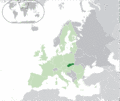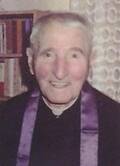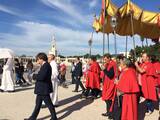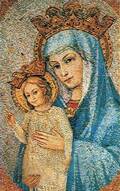SLOVAKIA - SLOVENSKO
Pope Saint John Paul II was a pilgrim to Slovakia 3 times: in 1990, 1995 & 2003, when he beatified the Slovak martyrs Basile Hopko and Zdenka Schelingová.
Here below are responses to Totus2us podcasts given by Slovaks
- ďakujeme vám všetkým ♥
You can download the free mp3 audio recordings individually by right/double clicking on the play buttons - Tu si môžete stiahnuť zadarmo mp3 audio nahrávky jednotlivo pravým / dvojitým kliknutím na tlačidlá prehrávania.
"Our Lady, Mary, means for me a source of strength. She's someone who I can always turn to if I'm worried, if I'm sad or if I'm not sure what to do next with my life. She'll always give me an answer and she'll always lead me the right way to make the right decision."
Alžbeta gives her something about Mary in English and Slovak.
"Thank you Mary for Jesus who you gave us as the greatest gift, and thank you for being our mother and protecting us from impure things in the world and covering us with your love, patience, and thank you for leading us into the life of joy. Thank you, Mary."
Anna gives her something about Maria in English & Slovak.
"Our Lady for me means mother: a mother who looks after me, who looks after my son, my husband, my family. Someone who takes care of us all and who I pray to every day. I feel she is blessing our lives and I am grateful for that."
Daniela gives her something about Mary in English & Slovak.
"Mary is for me an amazing and caring mother who is actually leading me on the journey towards Jesus, to know him more."
Erika gives her something about Maria in English and Slovak.
"For me Our Lady is like a mother and she intercedes for me a lot and she's the one I can really rely on and helps me when I'm struggling with things like school and everything."
Jan gives his something about Mary in English & Slovak.
"Mary is a union with God because she was the first who was hearing and understanding His will, through the Holy Spirit; and it was she who brings Jesus and it was she who is the first person who is near God and near Jesus, so when we pray it is her who is the closest."
"For me the rosary works in an incredible way. I'm not talking about some physical miracles but it gets written in my heart, in my soul, when I say the rosary."
Father Juraj Semivan chose Pater František Paňák SJ as his Man for Others, whom he knows from their time together at the Cathedral in the 1980s. Pater František is known as the 'angel of the city of Košickej'. ![]()
"Seeing a priest like that I thought 'Oh God, thank you.' I know there is no way I could be a priest like him but that's great because you can see that priesthood makes sense in one's life. I could see everyday all those people who visited him ... he was always so good to everyone, always laughing, just in a good mood, despite the suffering he went through, maybe just because of the suffering did he handle it."
"I have a really deep relationship with Our Lady because I feel that, well, she's the Patron Saint of my country and we've always had this devotion in Slovakia to Our Lady. So I think it's beautiful when we can think of her not only as our mother in the spiritual mother, but actually even as her looking at us every day and helping us in our daily tasks by encouraging us to follow Christ and lift up our cross every day."
Katarina gives her something about Mary in English & Slovak.
"Mary is for me the person I can rely on when I cannot. Through all my problems, I know that she is holding me, my hands. She is the mother."
"Mary is our Mother, she always keeps us in her hands, as with her Son Jesus."
Katarina gives her niečo o Márii in English & Slovak.
"I just really would like to recognise Mary in my life as my mother. Another thing I want to share is that I think she’s for me also a great example as a woman - the beauty of her heart, her humility. She kept everything that the Lord told her in her heart and was thinking about those words."
"I believe Mary is my mother, she loves me and she’s always with me … What I would like in life is to try to put my life in Mary’s hands and say yes to God as Mary did."
"Mary, our mother, is for me a special kind of woman and I really honour her. I always keep remembering when they were in Cana and she asked Jesus to turn the water into wine. At the end, as we know the story, he did, so I always try to pray to her as, when she asks Jesus, he will give it to us."
Lucia gives her something about Mary in English & Slovak.
"Mary is my idol in that she couldn't see all the consequences of what was going to happen to her but she said yes to God, whatever."
"Mary is my mother who loves me dearly. I can see her protection even at the time I didn't believe in her, and she is there for me whatever I need, and she has led me to lead a rosary group. She takes me to people and I think she is making me help others find her as a mother as well."
Marcela gives her something about Maria in English & Slovak.
Marcela gives her reflection on the Eucharist ![]()
"I feel like Jesus is always saying ‘thank you for receiving me with an open heart.’ And it’s one of the most beautiful moments I can have thinking that He is the one who created the earth and heaven, and He’s the one who saved us, He’s the one who died for me. But for me most importantly He’s the friend who’s knocking at the door of my heart. He wants to be there, He wants to help me with whatever I need, He wants to tidy up my mess, He wants to just spend time with me and those are the most beautiful moments."
"Maria is my patron and I really fly to her in troubles; and when I need some help or when I just need to speak to somebody and I know that maybe my colleagues will not understand so well. I try to tell her about everything, about my desires and dreams and about my study to succeed. I please her to give my pleases to Jesus and it's then on Him."
"In my stressful life, I know Mary stands by me. I imagine it every time I'm in church or when I think of my life and I know somebody stands by me all the time, and that's her."
"It might look like we don’t need anybody else to approach God but soon I realised that I actually don’t know how to approach God, how to love him, how to honour him and how to follow him, and I realised that Our Lady is the only one who can teach me, help me and give me not just an example but walk with me and support me with the graces. So I understood that if I want to see Jesus, I just knock on the house where he lives and it is Our Lady who opens the door. So I ask her, ‘I would like to see Jesus’ and she says ‘OK, come with me.’ And she takes me to Jesus. That’s all that she does, for me and for everybody else."
Mimi gives her something about Maria in English and Slovak.
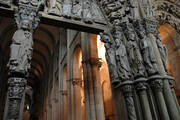
Mimi was a pilgrim on the Camino to Santiago de Compostela ![]()
"Coming to Santiago I was a little disappointed because all that way I had wanted to make it a spiritual impact in my life and I just couldn’t. First of all those worries of daily life: the food, the feet, where are you were going to sleep, we were cold … so it was challenging, a very challenging time. So I felt like I couldn’t really approach all that pilgrimage so much spiritually. So I thought, well I’m not sure if this is going to count into any spiritual building or anything like that. But I was really surprised coming to Santiago and we spent three days there and we really let the atmosphere of the Church and the prayers together soak in us and afterwards when I came back home, I really felt the difference. Somehow the Lord has blessed us, a different way than I was expecting and I was living from this experience for another month very strongly."
"Mary is an amazing mother who looks after us and me especially."
Monika gives her something about Mary in English & Slovak.
"Mary, I feel so privileged. I have a wonderful mother in this world, she is a treasure to me, and then I have you - I'm lost for words for how much I thank you. Thank you, Mary."
Monika gives her something about Mary in English & Slovak.
"Mary is for me my mother and mother of all Christians."
Robert gives his response in English & Slovak.
"I would say that Our Lady is a very special person for me. Through all my life I've been praying to Our Lady and there is the flavour in her life which I'm trying to implicate in my life and it means so much for me."
Stefan speaks in English and Slovak.
If you'd like to give your something about Mary,
please do get in touch with the Totus2us team
- as well as hopefully bringing you joy,
you'd be really helping Totus2us ♥
Totus tuus ego sum et omnia mea tua sunt.
Accipio te in mea omnia. Praebe mihi cor tuum, Maria. - St Louis de Montfort
St John Paul II took his motto Totus Tuus from this quote.
"I am totally yours and all that I have is yours.
I accept you for my all. O Mary, give me your heart.”
Pope John Paul II's reflection on his 1995 pilgrimage to Slovakia
General Audience, Wednesday 5 July 1995 - in Italian & Spanish
"1. Desidero oggi ringraziare Dio per la Visita nella Slovacchia, che ho potuto iniziare l’indomani della Solennità dei Santi Pietro e Paolo e continuare durante i giorni seguenti, fino al 3 luglio.
Ringrazio l’Episcopato della Slovacchia per l’invito e la preparazione pastorale di questa Visita. Ringrazio anche le Autorità civili, il Presidente della Repubblica Slovacca, il Primo Ministro ed il Governo, i Rappresentanti del Parlamento e le Autorità locali. Il mio pellegrinaggio è stato accompagnato dalla grande cordialità che scaturisce dal momento storico: era la prima volta, infatti, che il Papa visitava lo Stato slovacco indipendente.
Una storia che giunge fino ai tempi dei Santi Cirillo e Metodio
La Nazione slovacca ha un suo lungo passato, che giunge sino ai tempi di Cirillo e Metodio e della loro missione entro i confini del regno della grande Moravia. A quei tempi risale anche la sede vescovile di Nitra, una delle sedi più antiche di tutta l’Europa centrale. Nel corso della loro storia gli Slovacchi prima vissero nell’ambito della grande Moravia e poi divennero parte del regno ungherese; ciò durò fino alla prima guerra mondiale. Nell’anno 1918 nacque la Repubblica Cecoslovacca, nell’ambito della quale gli Slovacchi – escluso il periodo della seconda guerra mondiale – vennero modellando la loro esistenza statale fino all’anno 1993. Con viva ammirazione si deve dare atto alle due Repubbliche ora indipendenti, Ceca e Slovacca, di aver saputo dividersi in modo pacifico, senza conflitti e spargimento di sangue, a differenza di quanto è avvenuto, purtroppo, nella ex Jugoslavia. La divisione aveva alla base le molteplici diversità delle due Nazioni, pur simili sotto molti aspetti, in particolare quello linguistico. In questo modo la Nazione slovacca ha ora il suo Stato che abbraccia la vasta e fertile pianura al sud dei Carpazi e dei Monti Tatra.
La Visita nella Slovacchia mi ha permesso di conoscere meglio questo Paese ed i suoi abitanti, soprattutto nei principali centri della vita nazionale e religiosa.
Così dunque, il primo giorno sono stato a Bratislava, capitale del Paese, per poi andare all’incontro con la gioventù a Nitra. Nel secondo giorno ho visitato il Santuario mariano di Sastin situato al nord di Bratislava, nel territorio della Slovacchia occidentale. La mattina della domenica 2 luglio è stata dedicata alla canonizzazione dei tre Martiri di Kosice – Città in cui essi furono martirizzati nel secolo diciassettesimo. Alla canonizzazione hanno preso parte i Rappresentanti degli Episcopati di tutta l’Europa centrale. Nel pomeriggio mi sono recato a Presov, e la sera dello stesso giorno a Spis, da dove mi sono poi recato al Santuario mariano di Levoca. Spis è nella parte della Slovacchia che si stende ai piedi dei Monti Tatra, così che nell’ultimo giorno ho potuto rivedere questi monti, ai quali ero molto legato nella mia giovinezza. L’ultimo punto toccato nel viaggio è stata la città di Poprad, dalla quale sono ritornato a Roma.
La canonizzazione dei tre Martiri di Kosice importante avvenimento ecumenico
2. Lo scopo principale della mia visita nella Slovacchia era la canonizzazione dei tre Martiri di Kosice ed a questo avvenimento desidero dedicare una particolare attenzione. Quei Martiri sono: Marco da Krizevci, croato, canonico della Cattedrale di Esztergom e anche due Gesuiti: Melchiorre Grodziecki della Slesia, polacco, e Stefano Pongrácz, ungherese. Il loro martirio avvenne nello stesso periodo della storia d’Europa in cui, nella città di Olomouc, in Moravia, fu martirizzato san Ján Sarkander, che ho avuto la gioia di iscrivere poco tempo fa nell’albo dei Santi. I Martiri di Kosice diedero la vita per la loro fedeltà alla Chiesa, non cedendo alla brutale pressione dell’autorità civile dei sovrani, che voleva costringerli all’apostasia. Tutte e tre accolsero il martirio in spirito di fede e di amore verso i persecutori. Subito dopo la morte divennero oggetto di culto nella Slovacchia e, all’inizio del nostro secolo, dopo un accurato processo canonico, la Chiesa li ha proclamati Beati. Ora, essendo ormai matura la causa di canonizzazione, ho potuto proclamarli Santi durante la mia presenza a Kosice, con grande partecipazione della popolazione cattolica locale.
Questa canonizzazione è stata anche un importante avvenimento ecumenico, come è apparso sia nell’incontro con i Rappresentanti delle Confessioni protestanti, sia nella visita al luogo che ricorda la morte di un gruppo di fedeli della Riforma, condannati nel secolo diciassettesimo in nome del principio “cuius regio eius religio”. Del fatto fa memoria un monumento eretto nella città di Presov, davanti al quale ho sostato in preghiera.
Le persecuzioni hanno colpito in particolare i Greco-cattolici
3. Presov è anche il luogo in cui ha la sua residenza il Vescovo Greco-cattolico. La Chiesa Orientale, che ha i suoi fedeli da ambo le parti dei Carpazi, è nata dall’Unione fatta 350 anni fa in Uzgorod, nel territorio che prima apparteneva all’Ungheria e poi alla Repubblica Cecoslovacca ed che ora fa parte dell’Ucraina. L’Eparchia di Presov è, in un certo senso, una parte di questa Chiesa, nell’estrema zona occidentale, che concentra in sé i Greco-cattolici Slovacchi e i Ruteni oltre i Carpazi. Se tutta la Chiesa cattolica durante il Governo comunista nella Cecoslovacchia è stata sottomessa a gravi persecuzioni, queste hanno colpito in modo particolare i Greco-Cattolici slovacchi dell’Eparchia di Presov.
Dai Santuari mariani la forza nel periodo del comunismo ateo
4. Non si deve dimenticare che tutta la Chiesa della Slovacchia, che si trovava nell’ambito della Repubblica comunista cecoslovacca di allora, è passata attraverso dolorose persecuzioni. Quasi tutti i Vescovi sono stati privati della possibilità di esercitare il loro servizio pastorale. Tanti sono passati attraverso dure detenzioni in carcere. Alcuni di loro hanno terminato la vita come veri martiri – penso, in particolare, al Vescovo Wojtassák della diocesi di Spis, e al Vescovo Greco-cattolico Pavol Gojdic di Presov. Un testimone particolare di questa generazione di Vescovi imprigionati a causa della fede è il Cardinale Ján Chryzostom Korec, attuale Ordinario di Nitra.
La Chiesa della Slovacchia appena da alcuni anni gode della libertà religiosa, e forse questo fatto spiega la grande vitalità che ho potuto dovunque vedere e sentire durante questa mia Visita. Il problema della persecuzione della Chiesa in Slovacchia e la questione dei suoi Martiri richiedono una più profonda elaborazione, che non potrà non essere inclusa nella preparazione spirituale al Giubileo del secondo Millennio.
Se ci domandiamo da dove gli Slovacchi abbiano attinto la forza nel periodo della persecuzione, la risposta la troviamo, in modo particolare, visitando i Santuari mariani. Durante quel periodo difficile per la Nazione e per la Chiesa in Slovacchia, i Santuari sono diventati un grande punto di appoggio per la fede del popolo di Dio. Lì nessuna proibizione da parte della Polizia e dell’Amministrazione ha potuto vincere. Dai Santuari mariani quali Sastin e Levoca questa forza si è irradiata verso i fedeli, le famiglie, le parrocchie, verso tutta la Slovacchia.
Una visita che si inscrive nella vasta storia della salvezza del nostro secolo
5. Come appare da quanto ho detto, la visita della Chiesa in Slovacchia si inscrive nella vasta storia della salvezza nel nostro secolo. E, nello stesso tempo, si in- scrive nella storia della nazione Slovacca e del suo posto in Europa. Ecco, è in non piccola misura grazie alla missione della Chiesa che la nazione Slovacca ha ottenuto la sua indipendenza e come nazione, i cui cittadini sono in grande maggioranza cattolici, è entrata nella grande comunità dei popoli di tutto il mondo, e particolarmente dell’Europa. Essa reca a questa Comunità il contributo della sua identità culturale; reca anche la volontà di costruire la propria eredità e quella europea sui principi che scaturiscono dai diritti delle nazioni, adeguatamente riconosciuti e tutelati nel consesso internazionale, inclusi ovviamente quelli relativi alle minoranze.
La Sede Apostolica e il Papa esprimono riconoscenza per il patrimonio della Slovacchia indipendente, mettendo così in evidenza anche il diritto di questa Nazione al suo posto nella famiglia delle Nazioni europee come membro a pieno titolo."


